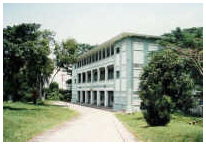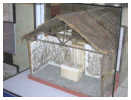The Painting of the Murals
As well as material things and food, the POWs in Changi required spiritual sustenance. Four Chaplains, fondly called ‘Padres’ by servicemen, found themselves in Roberts Barracks and busied themselves serving their fellow captives. They were the Reverends F.H. Stallard, G.J.M. Chambers, J.N. Duckworth and A.W. Pain. These Padres would all be instrumental in the painting of the Murals, one by making the provision of a chapel possible, and the others by supporting the artist.
 Padre Stallard negotiated with the Japanese and they grudgingly gave permission to make a chapel for the prisoners in the hospital area of the camp. With the help of the prisoners, he converted an end ground floor room of Barrack Block 151 in the dysentery wing. The chapel was fitted out with whatever furnishings were available, or could be made by the POWs. Some benches were found, and an altar and lectern were made. The chapel was dedicated to Saint Luke the Physician, an appropriate choice for the use Roberts Barracks was being put to.
Padre Stallard negotiated with the Japanese and they grudgingly gave permission to make a chapel for the prisoners in the hospital area of the camp. With the help of the prisoners, he converted an end ground floor room of Barrack Block 151 in the dysentery wing. The chapel was fitted out with whatever furnishings were available, or could be made by the POWs. Some benches were found, and an altar and lectern were made. The chapel was dedicated to Saint Luke the Physician, an appropriate choice for the use Roberts Barracks was being put to.
 Stanley was at first incarcerated in Roberts Barracks where he had designed murals of tropical scenes for staircases at the Barracks and painted tropical fish which he had kept at home. He soon found himself moved to Bukit Timah to join a forced labour party on construction work, making access roads for a memorial the Japanese were constructing on Bukit Batok. The memorial was destroyed after the war, but the access road, now called Lorong Sesuai, and the 125 stairs which led up to the memorial still exist. Whilst at Bukit Timah, Stanley painted some small religious pictures for the little chapel the POWs had built for themselves. Stanley became quite ill, suffering from a severe renal disorder and amoebic dysentery. On 23rd May 1942, Stanley, by then comatose, was moved from Bukit Batok to the hospital at Roberts Barracks.
Stanley was at first incarcerated in Roberts Barracks where he had designed murals of tropical scenes for staircases at the Barracks and painted tropical fish which he had kept at home. He soon found himself moved to Bukit Timah to join a forced labour party on construction work, making access roads for a memorial the Japanese were constructing on Bukit Batok. The memorial was destroyed after the war, but the access road, now called Lorong Sesuai, and the 125 stairs which led up to the memorial still exist. Whilst at Bukit Timah, Stanley painted some small religious pictures for the little chapel the POWs had built for themselves. Stanley became quite ill, suffering from a severe renal disorder and amoebic dysentery. On 23rd May 1942, Stanley, by then comatose, was moved from Bukit Batok to the hospital at Roberts Barracks.
By the middle of August, Stanley had recovered to a degree where he could be moved to the dysentery wing at Block 151. “There for the first time I came in contact with the chapel. I heard the choir singing”, he said many years later when being interviewed for the Singapore National Archives.
Stanley was a religious man and and was also blessed with a talent for art. Before the war he had studied at the Hornsey School of Art in London, and worked as a designer of advertising posters for cinemas. Padres Chambers and Pain had heard that he had decorated the prisoners’ chapel at Bukit Batok, so they asked him if he would paint murals for Saint Luke's Chapel. Stanley agreed, and asked for the dimensions of the chapel walls, and painting materials. He sought inspiration for his work in the Gospels, reading all four of them and as he said, “selecting the texts which would form the basis of a coherent group of paintings”.
Paint was not readily available, but with the aid of other prisoners, who unquestionably put themselves at great risk, colours and materials to make paint from were acquired. Brown camouflage paint was found, as were a small amount of crimson paint and white oil paint. Billiard cue chalk was crushed and used to produce blue. After the first mural was completed, a large drum of grey paint was acquired to add to Stanley’s palette.
Despite his continuing illness, Stanley began work on the first of the murals in early September 1942. He could only paint for a limited period each day, perhaps only 15 minutes at a time followed by a rest - lying down behind the curtain of the chapel altar. To compensate as much as he could for the lack of coloured paint, Stanley resorted to using large brush strokes and big areas of solid colour when painting. Despite this, after three murals, he only had grey paint left.
Interestingly, no one had asked the Japanese for permission to paint the murals, and at no stage did they interfere with Stanley’s work on them. Many years later Stanley recalled, “The Japanese soldiers would come in, the Japanese sergeant and Korean guards ...... They would look on and never interfere”. The Japanese did put a stop to one of his other works. Stanley had started to draw a map of Europe on the wall of the Officers Mess and this was stopped. The map was to allow the officers to follow the progress of the war received on the clandestine radio sets in the camp.
Altogether, Stanley painted five large murals on the walls of the chapel. On one wall he painted ‘The Nativity’ and ‘Saint Luke in Prison’, each mural about three metres long. On the other wall are ‘The Last Supper’, ‘The Crucifixion’ and ‘The Ascension’. All are subjects which are at the very heart of Christian belief. The pleasure and spiritual uplift these murals must have given to the POW worshipping or praying quietly in the chapel can only be imagined. The links above take you to a large picture of each mural, and the background to its painting.
 The Murals were completed in May 1943. The end result of Stanley’s labours being an inspiringly decorated Chapel. Here POW could come for religious services, just to sit and think of home, or talk quietly to each other. The solace and spiritual strength given to POW by the Chapel, and indeed by other Chapels built in Malaya and Singapore can only be imagined by we who never went through the brutal captivity experienced by the POW and civilian internees.
The Murals were completed in May 1943. The end result of Stanley’s labours being an inspiringly decorated Chapel. Here POW could come for religious services, just to sit and think of home, or talk quietly to each other. The solace and spiritual strength given to POW by the Chapel, and indeed by other Chapels built in Malaya and Singapore can only be imagined by we who never went through the brutal captivity experienced by the POW and civilian internees.
The painting of the Murals may well have saved Stanley’s life. He had been scheduled to join a working party being sent north by the Japanese, but his commanding officer successfully pleaded with the Japanese for him to be allowed to complete his painting. Most of those who went on the working party never returned.
After completing the murals, Stanley's health improved for a short period, but then he suffered from a severe form of dysentery and haemorrhaged badly. He became paralysed and affected by spondilytis. It was thought that he would die, and he was so ill that he thought that he really wanted to die. Prayers led by Padre Chambers for him, were said in front of the mural of the Crucifixion.
In 1944, Stanley was moved to Kranji where he spent the remainder of the war. Before he moved, he was able to visit Saint Luke’s Chapel for a last look at his murals. At Kranji, Stanley was able to study Greek history and continue drawing. Padre Chambers did not survive the war. He died as a direct result of ill treatment by the Japanese.
On 15th August 1945, over their clandestine radios, came the news that the surviving prisoners had long hoped for - that of the Japanese surrender. The prisoners then found themselves in a quandary as the Japanese themselves did not tell them of the surrender. Not until the 17th August did the Japanese admit that the war was indeed over. Although their ordeal was finally over, men continued to die from the treatment they had endured under the Japanese. Many of the survivors would carry the mental and physical scars of their anguish for the rest of their lives.
Stanley Warren believed that his murals had been destroyed by allied bombing towards the end of the war. He had been told that the Chapel had been completely destroyed by the bombing, and could not bear to go and see the ruins. He returned to England and quietly picked up the threads of his life. Stanley became an art master at a the Sir William Collins School (now called South Camden Community School) in London.





